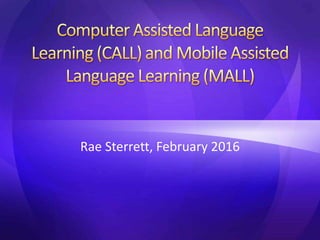
CALL and MALL Presentation-Draft
- 1. Rae Sterrett, February 2016
- 3. What went wrong? What went right?
- 5. • CALL… • Can be used in one place (computer lab) • Offers more information on the screen • Easier to ensure that students are all covering the same material, since it is easier to see if the students have gotten off- task • MALL… • Allows students the freedom to move • Allows students to move at different speeds • Can gather information from different locations and send it to a central location (e.g. scavenger hunt)
- 8. Positives • Students generally enjoy the “game-like” features of the website • It’s free, and so is the app version! • It ensures accuracy. • Concepts are recycled, so students are consistently exposed to different aspects of the language. Drawbacks • There is only one set way to move through the site, you cannot adjust the order in which you learn the material • The sentences are often uncommon or sound unnatural • Many phrases have no direct translation.
- 9. • Your input and exercises are checked by native speakers • You can help others learn your native language by providing feedback • Offers spoken prompts, listening practice, reading passages and writing exercises…all four skills!
- 10. • You get to create the cards! • It will recycle the words you have the most difficulty with, in order to ensure you keep practicing the ones you need to practice most
- 11. • What are some differences between regular phones and smart phones? • What can you use on BOTH kinds of devices?
- 12. • Text messages • Notes • Phone calls • Audio recorder • Pictures/Video on some devices
- 13. • Ask students to send a text message as their homework assignment, when only one sentence is sufficient • Ask students to send each other information, and one person from their group has to send an answer to a group problem to the teacher • Introductory text messages- send their name, age, class information at the start of the term so you can contact each other easily.
- 14. • Ask students to go out of the classroom and write down in their notes things that they know how to say in English, and things they don’t know how to say in English (they write the latter in their L1) • Have them write a paragraph for homework in their notes and show it to the teacher the next day
- 15. Ask the students to call you and talk about a topic, or ask them to leave an appropriate voice mail message about a topic.
- 16. • Most phones have an audio recorder. In lieu of a phone call, a student could record a conversation or talk about a topic. • The benefit is that if a student doesn’t like their first recording, they can redo it.
- 17. • Mostly exists only on smart phones, but many regular phones will now allow for photos too. • Send students out to take photos of objects that connect to the topic in class, or ask them to describe their pictures using grammatical features. • Videos can be shot to demonstrate conversation skills, or to demonstrate knowledge of a topic or grammatical skill.
- 18. • Duolingo • WordLens • MobiLibs • QR Reader • Voice Thread • Twitter
- 19. • Very similar to using Duolingo on the computer, but with one important addition: speaking practice! • Use it everywhere, you just need an internet connection • 8 languages available, more being added
- 20. Translates individual words Occasionally gets inventive with translations No Internet connection needed once the app is downloaded You have to set up the languages on your phone. Asian languages with different alphabets (Chinese, Korean, Japanese, Russian) are available as well!
- 21. • More of a fun activity to reinforce grammar than one to organize a lesson around • Allows students to create funny stories in English by putting in different forms of grammar, such as verbs or adjectives • Best for upper-level bachillerato or IB students
- 22. • So here’s a terrific idea for a class… • Set up and print QR codes that link to websites with audio recordings of vocabulary words. Put the QR codes on the vocabulary you want students to learn, or pictures of the vocabulary you want them to learn, and have them use the QR codes to hear the recordings. • You can use it to link to websites or visuals to assist students’ learning as well. This is one site: http://www.qr-code-generator.com/
- 23. Communicate, Collaborate and Connect
- 24. • Students can link to an article and write a summary of it in their tweet. • Students put up an image or link to an image, and describe it • Students ask questions or send responses via tweets
- 25. • Work in pairs or groups of 3 with someone who teaches the same level as you • Choose only one method studied here today and design a lesson using that method • 10 minutes to work and then a 2-minute presentation!